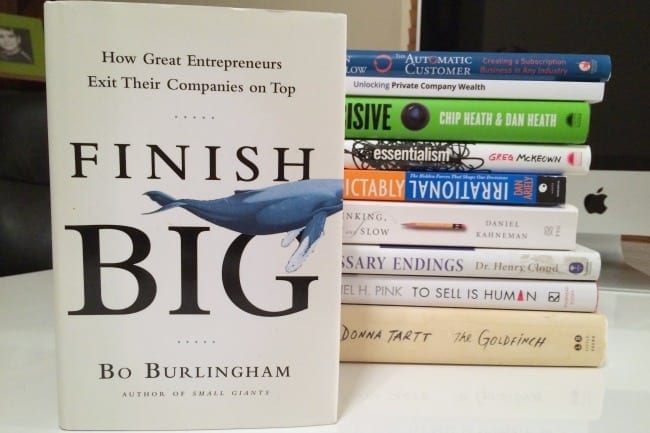If you’ve ever perused Amazon.com or your local bookstore looking for information on how to exit your business, you’ve probably come up with a short list of resources. While there are countless titles about starting and running a business, there are precious few that tackle the work of how to successfully leave one.
Fortunately, Bo Burlingham — author of Small Giants and editor at large at Inc. magazine — goes a long way towards filling the void with his latest book, Finish Big: How Great Entrepreneurs Exit Their Companies on Top.
Finish Big is filled with valuable information about how — and why — to exit your business, most of it conveyed through the stories of actual business owners. Here are a few key take-aways:
There are three stages of business ownership
Stage one of business ownership is the start-up ramen noodle phase. If you manage to beat the odds and survive stage one, you will enter the second phase of ownership, which is typically focused on maintaining and growing your business. During stage two, many owners are satisfied with achieving a certain level of growth that feels comfortable. Rather than look to the future, they simply strive to maintain the business at its current level — as well as their lifestyle outside the business — indefinitely.
But the ownership journey doesn’t top out at stage two. There is a third and equally critical phase of owning a business: planning and successfully executing your departure from it. Why is stage three so often overlooked?
The vast majority of business owners don’t give their exit much thought until, for one reason or another, they have to — at which point their options are often starkly limited.
Some people, like serial entrepreneur and best-selling author John Warrillow, feel strongly that you have limited bragging rights as a business owner if you haven’t completed all three stages of business ownership, including a successful exit.
“It’s like passing the 26.2 mile mark of a marathon, or crossing home plate after a home run,” Mr. Warrillow explains in chapter one. “I don’t believe you are really an entrepreneur until you’ve exited, because you haven’t completed the cycle. You’re still standing on third base. It’s not about starting. Anyone can start a business. Until you’ve actually sold one, you haven’t touched all the bases.”
Whether or not you agree with Mr. Warrilow, Finish Big gives several examples of what happens when entrepreneurs underestimate or fail to address the exit stage of their ownership journey. Spoiler: You’ll be hard-pressed to find happy endings to these stories.
There are four stages of an exit
It is commonly said that selling or otherwise exiting your business is a process, not an event. Finish Big describes the exit process as having four distinct stages:
STAGE 1: EXPLORATORY
This stage involves exploring different exit options and determining which one is the right fit for your business, personal and financial goals. Stage one is a logical time to get a business valuation, so that you can get an idea of what you’d walk away with if you sold today.
This is also the time to do some serious soul-searching about what you would like to do after you no longer own your business. Mr. Burlingham offers the following caution numerous times throughout the book:
Hastily planned exits seldom turn out to be happy ones. They are particularly difficult for owners who haven’t given much thought to what comes next. Instead, they’re guided by what other people want.
STAGE 2: STRATEGIC
This stage involves learning how to view your business like a potential buyer, so that you can understand what qualities bolster the value of your business, and which ones pull it down. It is also the time to fill in the gaps by adding qualities to your business that buyers both look and pay for.
If this stage feels like more trouble than it’s worth, Mr. Burlingham points out that the characteristics that buyers look for in a business are ones that you should be cultivating as an owner anyway.
You don’t need $5 million in EBITDA to develop the disciplines and best practices valued by the most astute investors and acquirers. If you do, you’ll have a stronger, more resilient, and more valuable company no matter what sort of exit you eventually choose.
STAGE 3: EXECUTION
This stage is all about getting the deal done. Your success at this stage of the game will be largely influenced by the caliber of professionals you assemble to help you.
The book gives a brief description of the M&A landscape, breaking deal professionals into two main categories: business brokers and investment bankers. I would elaborate by saying that there is a third category of professionals that sits between the two, typically referred to as M&A brokers or M&A advisors.
This middle group is where you will find firms like Allan Taylor. These advisors tend to work with businesses that are too large or complex for a Main Street business brokerage (>$2 million in annual revenues), but too small for investment bankers (<$50 million).
There is a lot of overlap in the world of deal professionals, which makes it critical that you interview multiple firms to find the right fit for you, your family and your business. Regardless of how you slice and dice the M&A landscape, Mr. Burlingham is crystal clear on one thing:
The closer you get to an exit, the more specialized the help you will need.
STAGE 4: TRANSITION
While the deal may be done, there will still be work involved in getting yourself out of your business permanently and into whatever comes next. Again, another warning not to gloss over this part of the process:
Until you’ve moved on — not just physically but psychologically — to a new venture, a new career, a redefined role, or even retirement, your exit isn’t complete.
Exits require managing time and timing
Time is a critical component of exit planning. Finish Big addresses the myriad ways in which time can either work for or against you:
- There is a window of time during which the value of your business will peak. Hint: Timing the “valuation window” has nothing to do with when you want to sell.
- Exits take more time than most owners realize. It takes an average of three years to execute your exit and transition out of your business (stages 3 and 4 alone).
- When it comes to choosing a successor, allow time to make a mistake.
- Every exit is affected by the time allotted to plan for it.
The money is the easy part
When it comes to how you will leave your business, the most difficult questions you will grapple with are the existential ones. I’ve often thought that it’s the people who handle the “soft” (i.e. emotional and psychological) part of the process who have the best outcomes, and Mr. Burlingham seems to agree.
One business owner put it bluntly: “I can’t believe the number of people who just freak out after the sale.”
You can hire specialists to handle the financial details of any transaction — or to manage your liquid wealth after a sale — and there will be a team of capable people running the Newco after you leave. But only you can manage the Newlife you will embark on post-exit.
In Mr. Burlingham’s experience, the happiest owners are those who use their financial independence to do something meaningful in their next act. For many, it’s still tied to the realm of business and entrepreneurship. For others it may be volunteerism. Whatever it is, they find their bliss, and use their time and financial freedom to immerse themselves in it.
No matter what industry you are in, how big your business is or how long you’ve been an owner, Finish Big offers much-needed insight into successfully navigating the elusive third phase of business ownership: the exit. To read the book is to live vicariously through the experiences of business owners who have gone before you. Not only are you sure to learn from their stories, you will likely come away with a better idea of what you’d like your own big finish to look like.



